14 Using the Main Menu
- Using the Mouse: Right-click and click Main Menu.
To open the Main Menu:

- PLAYBACK: Open Search/Playback mode. For details, see
- BACKUP: Export files to USB device. For details, see 12 Backup .
- CAMERA: Open the menu to manage IP cameras connected to the network (see 5.11 Connecting Cameras to the Local Area Network (LAN) for details), set recording parameters, and assign custom titles for your cameras.
- INFO: View system information.
- SETTING: Configure general system, schedule, network, recording, display, and motion settings. Restore system to factory defaults.
- SHUTDOWN: Logout, restart, or shutdown the system.
14.1 Camera
Open the Remote Device menu to manage IP cameras, set recording parameters, and assign custom titles for your cameras.

14.1.1 Remote Device
The Remote Device menus allow you to add cameras over the local area network (LAN), configure camera image settings, view
camera status, and upgrade camera firmware.
- See 5.11 Connecting Cameras to the Local Area Network (LAN) for instructions on connecting cameras to the NVR over the network.
- See 8.3 Adjusting Camera Image Settings for details on setting up camera image settings.
14.1.2 Viewing Camera Status
The Camera Status menu allows you to view the connection and alarm status for all connected cameras.
-
From the Main Menu, click
and select Remote Device>Status.
To view camera status:
14.1.3 Viewing Camera Firmware Versions
You can use the Firmware menu to view firmware versions for connected cameras.
-
From the Main Menu, click
and select Remote Device>Firmware.
To view camera firmware versions:
14.1.4 Upgrading Camera Firmware
You can update the firmware for connected IP cameras through the NVR. Firmware upgrades provide enhanced functionality for
the cameras. Typically, a camera firmware upgrade will not be necessary unless directed to do so by technical support.
- Download the camera firmware file.
- Extract the firmware file and copy it to a USB thumb drive (not included).
- Insert the USB thumb drive (not included) into a USB port on the system.
-
Right-click and select Main Menu. Click
and select Remote Device> IPC Upgrade.
- Click Select. Select the firmware file on the USB drive and click OK.
- Check the cameras you would like to apply the upgrade to in the list and then click Start Upgrade.
To upgrade the camera firmware:
14.1.5 Recording
The Recording menu allows you to set recording parameters for your cameras, such as the resolution and frame rate.
14.1.6 Configuring Recording Quality
The system employs two video recording streams, a Main Stream and a Sub Stream. The Main Stream records high quality video
to your system’s hard drive. The Sub Stream records lower resolution video for efficient streaming to devices over the Internet.
You can customize the video quality settings for these streams according to your needs.
-
From the Main Menu, click
and select Recording>Recording.
- Under Channel, select the camera you would like to configure.
- Under Type, select the recording type you want to configure the recording quality settings for.
-
Configure the following settings. Settings for the Main Stream are in the left column. Settings for the Sub Stream are in
the right column.
- Compression: Select the video compression type that will be used. For H.265 compatible cameras, it is recommended to select H.265, as it will have the best performance and use the least amount of disk space.
- Resolution: Select the resolution that you want to use to record the selected channel. Higher resolutions create a more detailed image, but take up more hard drive space to record and require more bandwidth to stream to connected computers or mobile devices.
- Frame Rate (FPS): Select the frame rate in Frames Per Second (FPS) that each stream will record at. A higher frame rate provides a smoother picture, but requires more storage and bandwidth.
- Bit Rate Type: Select CBR (Constant Bit Rate) or VBR (Variable Bit Rate) to determine the bit rate type. If you select VBR, select the Quality from 1 (lowest) to 6 (highest).
- Bit Rate (Kbps): Select the bit rate for each recording stream. A higher bit rate results in a better image, but increases the amount of hard drive space or bandwidth required.
- (Optional) Click the Copy button to copy recording settings to other channels.
- Click OK to save changes.
To configure recording quality:
14.1.7 Configuring Snapshot Recording Settings
The system can be set to record snapshot images when a camera detects motion. These snapshots can be viewed through the Search
menu or can be attached to email alerts and push notifications. The Snapshot tab in the Recording menu controls the quality
and recording parameters for each camera.
-
From the Main Menu, click
and select Recording>Snapshot.
- Under Snapshot, select the number of snapshots the system will take when the snapshot button is pressed.
-
Configure the following settings for snapshots saved automatically from motion detection or the snapshot schedule:
- Snapshot: Select the number of snapshots (up to 5) the system will take each time.
- Channel: Select the channel you would like to configure.
- Mode: Select Timing for the system to take snapshots according to the snapshot schedule (see 14.3.16 Configuring the Snapshot Schedule ) Select Trigger for the system to take snapshots only when triggered by motion detection (snapshot must be enabled in the Motion Detect menu; see 14.3.7 Configuring Motion Detection ).
- Image Size: The image size is the same as the Main Stream resolution of the camera.
- Image Quality: Select the snapshot image quality between 1 (lowest) and 6 (highest)
- Click OK to save changes.
To configure snapshot recording settings:
14.1.8 Configuring Video Overlay Settings
The Overlay tab allows you to configure the text and information that appears overtop of the camera image, such as time and
channel display.
-
From the Main Menu, click
and select Recording>Overlay.
- Under Channel, select the camera you would like to configure.
-
Configure the following settings:
- Time Display: Check this option to display the time information. Click Set next to Time Display to choose the position of the time display overlay. A live view screen of the currently-selected channel appears. Click and drag the time display to position it in any desired area. Right-click to exit the live screen
- Channel Display: Check this option to display the channel information. Click Set next to Channel Display to choose the position of the channel display overlay. A live view screen of the currently-selected channel appears. Click and drag the channel display to position it in any desired area. Right-click to exit the live screen.
- Privacy Masking: Check this option to hide certain parts of the camera image in video recordings. The numbered boxes under the Privacy Masking check-box signifies the number of black boxes (masks) you want over your camera image. Select the desired number of boxes (you can configure up to four boxes). Click Set to choose the position of the mask overlay. You can also re-size the black boxes. Right-click to exit the live screen.
- (Optional) Click the Copy button to copy overlay settings to other channels.
- Click OK to save changes.
To configure video overlay settings:
14.1.9 Creating Custom Channel Names
You can assign custom names to your cameras. For example, you can name your cameras based on their location (e.g. hallway
or front door).
-
From the Main Menu, click
and select Channel Name.
-
Enter a custom name for each channel.
- Click OK to save changes.
To create custom channel names:
14.2 Info
Info contains menus that show you system information.

14.2.1 HDD Info

The HDD Info sub-menu shows information related to the hard drives installed in the system, including capacity, status, and
type.
-
From the Main Menu, click
and then click Info>HDD Info.
To access the HDD Info menu:
14.2.2 Record Info

The Record Info menu shows the start and end times of recordings saved on the hard drive.
-
From the Main Menu, click
and then select Info>Record Info.
To access the Record Info menu:
14.2.3 Version

The Version sub-menu allows you to view information about the current firmware installed on the system.
-
From the Main Menu, click
and then click Info>Version.
To access the Version menu:
14.2.4 Event Info

The Event Info menu shows you a display of system alarms. Activated alarms are highlighted in white. Additional info such
as channels that are currently detecting motion is shown.
- No HDD: No hard drive is detected.
- Disk Error: Hard drive error detected.
- Disk Full: Hard drive is full.
- IP Conflict: More than one device on the network is using the same IP address.
- Net Conflict: System is not connected to the network.
- MAC Conflict: More than one device on the network is using the same MAC address.
- Video Loss: Shows disconnected channels.
- Tampering: Camera tampering alarm has been triggered (e.g. someone has tampered with the camera)
- Motion Detect: Shows channels with active motion alarms.
The following alarms are shown in the Alarm Status menu:
-
From the Main Menu, click
and then select Event.
To access the Event Info menu:
14.2.5 Online Users

The Online Users menu shows a list of users connected to the system using computers or mobile devices.
-
From the Main Menu, click
and then select Network.
To access Online Users:
14.2.6 Load

The Load menu shows you the network traffic your system is sending and receiving.
-
From the Main Menu, click
and then select Network>Load.
To access Load:
14.2.7 Test

The Test menu allows you to test if your system can connect to other devices over the LAN or Internet. You can enter the IP
address of a device and click Test to determine if your system can connect to it.
-
From the Main Menu, click
and then select Network>Test.
To access Test:
14.2.8 BPS
The BPS sub-menu shows the bitrates of connected cameras. The bitrate is the amount of data the camera is sending to the system.

-
From the Main Menu, click
and then select BPS.
To access BPS:
14.2.9 Log
The Log sub-menu allows you to search for system logs.

-
From the Main Menu, click
and then select Log.
- Under Type, select the log type to search for.
- Under Start Time and End Time, select the start and end time for your search.
- Click Search.
- (Optional) Click Backup to export logs to a USB thumb drive connected to the system.
To search for system logs:
14.3 Setting
The Setting menu allows you to configure general system, schedule, network, recording, display, and motion settings. It also
allows you to restore the system to factory defaults.

14.3.1 Network
The Network menu allows you to configure network parameters for your system.
14.3.2 Selecting DHCP or Static IP Address (TCP/IP)
The TCP/IP menu allows you to configure IP address settings.
To configure IP address settings:
-
From the Main Menu, click
and then select Network>TCP/IP.
-
Check DHCP (recommended) to let the system automatically obtain an IP address from the router or uncheck to assign a static IP address.
If you uncheck DHCP, configure the following:
- IP Address: Enter the IP address you would like to assign to the system. Make sure that no other device on your network is using the same IP address.
- Subnet Mask: Enter the subnet mask for your network.
- Default Gateway: Enter the gateway address for your network.
- Preferred DNS: Enter the address of your primary DNS server.
- Alternate DNS: Enter the address of your secondary DNS server.
- Click OK to save changes.
14.3.3 Configuring System Ports (Connection)
The Connection menu allows you to configure ports used by the system.
If you are using DDNS connectivity, port forwarding is required for the HTTP Port (default: 80) and TCP (Client Port) (default: 35000).
To configure system ports:
-
From the Main Menu, click
and then select Network>Connection.
- Configure the ports as needed and click OK to save changes.
14.3.4 Configuring Email Alerts
You can configure the system to send out email alerts for motion detection or other events.
-
From the Main Menu, click
and then select Network>Email.
- Check Enable to enable email notifications.
To configure Email Alerts:
- Under Mail Select, select Lorex Mail to use the Lorex email server to send out alarm notifications. This is the recommended setting.
-
Configure the following:
- Email Schedule: Configure time periods during which email alerts will be sent.
- Receiver: Enter the email address that will receive alerts.
- Sender: Enter the sender’s email address.
- Subject: Enter the subject line for the email alert.
- Attachment: Check to include a jpg image attachment of the camera.
- Interval: Enter the interval between alert emails.
- Health Enable: Check to enable health check emails. Health check emails will be sent periodically to ensure that the system is functioning normally. If you enable health check emails, enter the Interval in minutes.
- Click Test to send a test email.
- Click OK to save settings.
If you want to use Lorex’s email server (recommended):
-
Configure the following:
- SMTP Server: Enter the SMTP server address.
- Port: Enter the port used by the SMTP server.
- Anonymous: Check if your server supports anonymous log ins. Otherwise, leave this unchecked.
- User: Enter the SMTP user name.
- Password: Enter the SMTP password.
- Receiver: Enter the email address that will receive alerts.
- Sender: Enter the sender’s email address.
- Subject: Enter the subject line for the email alert.
- Attachment: Check to include a jpg image attachment of the camera.
- Encrypt Type: Select SSL or TLS if your server uses encryption. Select None if your server does not use encryption.
- Interval: Enter the interval between alert emails.
- Health Enable: Check to enable health check emails. Health check emails will be sent periodically to ensure that the system is functioning normally. Also, enter the interval in minutes for health check emails.
- Click Test to send a test email.
- Click OK to save settings.
If you want to use your own email server (advanced):
14.3.5 Configuring Switch Settings (Advanced)
You can configure the networking settings for the internal PoE switch.
- From live view, right-click and select Main Menu.
-
Click
>Network>Switch .
-
Configure the IP Address, Subnet Mask, and Default Gateway for the internal PoE switch.
- Click OK. Click Save to save changes. The system will restart.
To configure switch settings:
14.3.6 Event
The Event menu allows you to configure settings for motion detection, video loss, and system warnings.
14.3.7 Configuring Motion Detection
Motion Detection events allow the system to mark footage that has motion. This allows you to quickly locate relevant footage
through Search. You can also configure system responses to motion detection events, such as activating the system buzzer or
sending an email alert.
To configure Motion Detection events:

-
From the Main Menu, click
and then click Event>Motion>Motion Detect.
- Under Channel, select the channel you would like to configure.
- Check Enable to enable motion detection on the selected channel.
-
Click Set next to Region to configure which areas of the image will be enabled for motion detection. A grid will appear over the camera’s live view.
Motion Grid
- Areas enabled for motion detection are shown in color and areas that are disabled are transparent.
- Hover the mouse at the top of the screen to select which motion area you would like to configure. You can set up to 4 motion detection areas and customize the sensitivity and threshold for motion detection separately for each area between 0 (lowest) and 100 (highest).
- The Sensitivity determines how sensitive the camera is to motion. For example, if the sensitivity is high, small amounts of motion are more likely to trigger an event. It is recommended to select a Sensitivity between 30~70.
- The Threshold determines how much motion is required to trigger an event. If the amount of motion exceeds the threshold, an event occurs. It is recommended to select a Threshold between 10~50.
- Right-click when finished.
- Under Post_REC, enter the time the system will record after a motion event occurs.
- To configure a schedule when motion detection will be enabled on this channel, click Set next to Period. Configure times when motion detection will be enabled. For example, you may want to disable motion detection during business hours and enable it outside of business hours. Click OK when finished.
-
Configure the following system actions when motion is detected:
- Show Message: Check to enable an on-screen pop-up when one of your cameras detects motion. On-screen pop-up shows the channels an event occurred on and the type of event.
- Send Email: Check to enable email alerts. You must configure email alerts before you will be able to receive them (see 14.3.4 Configuring Email Alerts ).
- Channels: Select the channels that will record when motion is detected on the selected channel.
- PTZ Activation: Check to enable PTZ actions when motion is detected (PTZ camera required; not included). Click Set to select which PTZ actions will be taken by each camera.
- Sequence: Check to enable a custom sequence mode when motion is detected on the selected channel. Then click the channels you would like to display in the custom sequence mode.
- Snapshot: Check to save a snapshot when the camera detects motion.
- Log Enable: Check to activate log.
- Buzzer: Check to enable the system buzzer.
- Click OK to save changes.
14.3.8 Configuring Video Loss Settings
Video Loss occurs if the system loses connection to one of the cameras.
-
From the Main Menu, click
and then click Event>Motion>Video Loss.
- Under Channel, select the channel you would like to configure.
- Check Enable to enable video loss events for the selected channel.
-
Configure the following to customize settings for video loss events:
- Period: Click Set to configure a schedule for video loss events. It is recommended to leave this on the default setting, so you can be alerted at any time one of your cameras loses video.
- Show Message: Check to show a popup message on the monitor if one of your cameras loses video.
- Send Email: Check to enable email alerts. You must configure email alerts before you will be able to receive them (see 14.3.4 Configuring Email Alerts ).
- Channels: Click the checkbox to enable video recording when video loss occurs. You can then select the channels the system will record when video loss occurs on the currently selected channel.
- PTZ Activation: Check to enable PTZ actions when video loss occurs (PTZ camera required; not included). Click Set to select which PTZ actions will be taken by each camera.
- Post_REC: Enter the number of seconds the system will record after video loss occurs.
- Sequence: Check to enable a custom sequence mode when motion is detected on the selected channel. Then click the channels you would like to display in the custom sequence mode.
- Snapshot: Click the box to enable snapshot recording when video loss occurs. You can then select which channels will save snapshots when video loss occurs on the currently selected channel.
- Log Enable: Check to activate log.
- Buzzer: Check to enable the system buzzer when video loss occurs on the currently selected channel.
- Click OK to save changes.
To configure Video Loss settings:
14.3.9 Configuring Tampering Settings
Allows you to set up your camera to detect video tamper and trigger alerts.
-
From the Main Menu, click
and then click Event>Motion>Tampering.
- Under Channel, select the channel you would like to configure.
- Check Enable to enable video tamper alarm for the selected channel.
-
Configure the following to customize settings for video loss events:
- Period: Click Set to configure a schedule when video tamper alarm will be activated. It is recommended to leave this on the default setting, so you will be alerted any time one of your cameras is tampered with.
- Show Message: Check to show a popup message on the monitor if one of your cameras is tampered with.
- Send Email: Check to enable email alerts. You must configure email alerts before you will be able to receive them (see 14.3.4 Configuring Email Alerts ).
- Channels: Click the checkbox to enable video recording when video tamper occurs. You can then select the channels the system will record when video tamper occurs on the currently selected channel.
- PTZ Activation: Check to enable PTZ actions when video tamper occurs (PTZ camera required; not included). Click Set to select which PTZ actions will be taken by each camera.
- Post_REC: Enter the number of seconds the system will record after video tamper occurs.
- Sequence: Check to enable a custom sequence mode when motion is detected on the selected channel. Then click the channels you would like to display in the custom sequence mode.
- Snapshot: Click the box to enable snapshot recording when video tamper occurs. You can then select which channels will save snapshots when video tamper occurs on the currently selected channel.
- Log Enable: Check to activate log.
- Buzzer: Check to enable the system buzzer when video tamper occurs on the currently selected channel.
- Click OK to save changes.
To configure Video tamper alarm settings:
14.3.10 Configuring Deterrence Settings (Deterrence cameras only)
Set preferences for automatic warning lights to trigger on compatible Lorex deterrence cameras. For a complete list of compatible
deterrence cameras, see
www.lorex.com
.
To configure automatic deterrence:
-
From the Main Menu, click
and then click Event>Motion>Deterrence.
-
Select the channel of the deterrence camera to configure next to Camera.
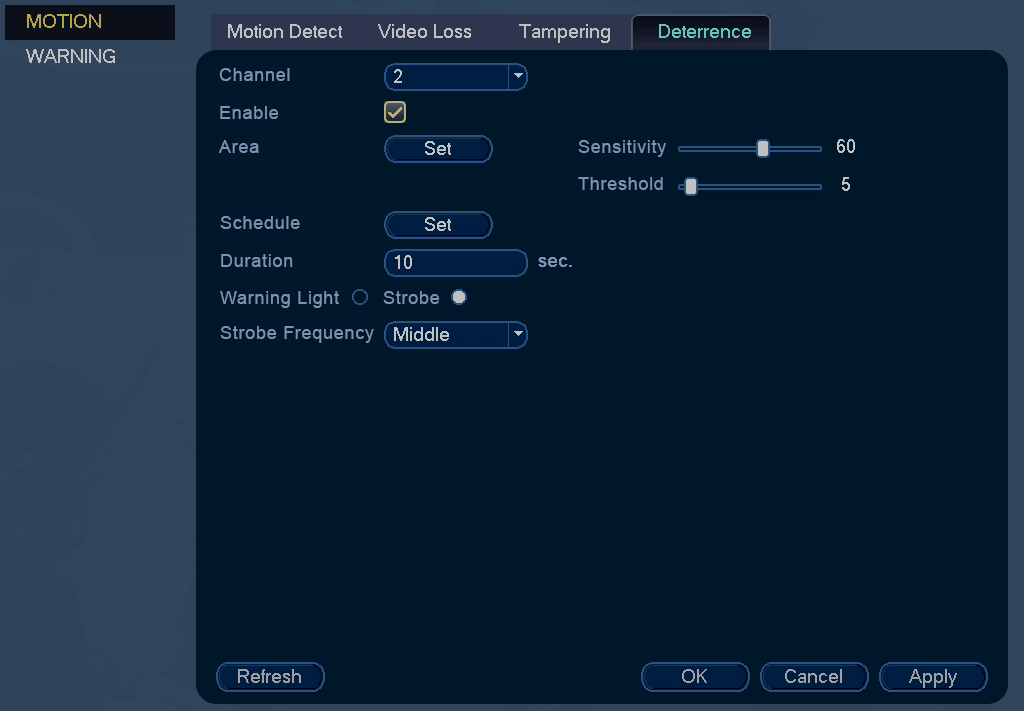
- Click the Enable checkbox to enable automatic warning light deterrence.
-
Click Set next to Area to set the active area for automatic deterrence:
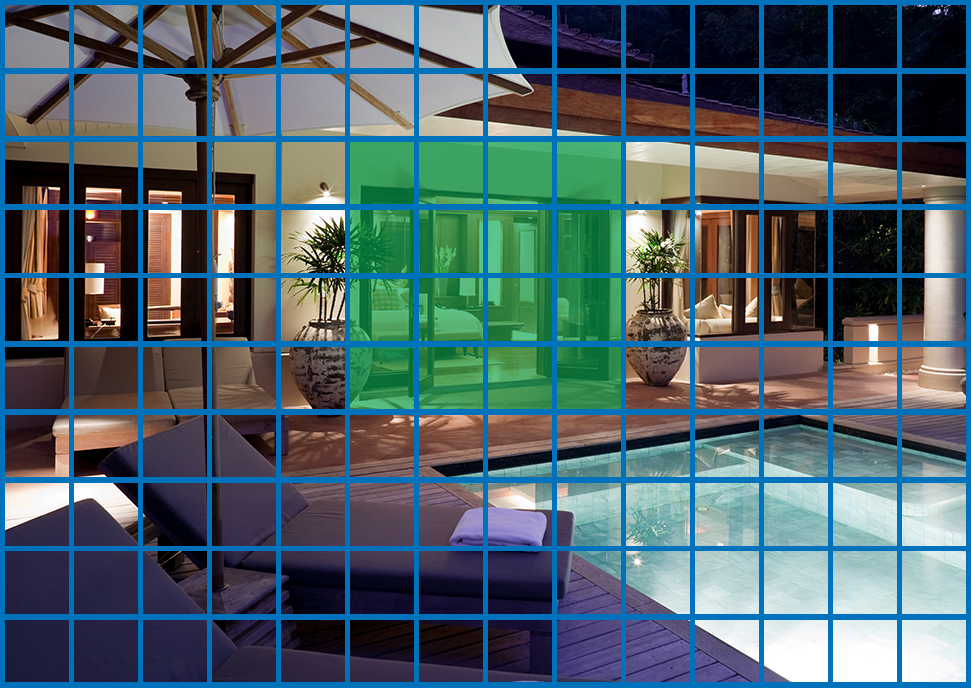
- The camera image appears with a grid of green boxes over top. The green area is the active area for deterrence.
- Click or click-and-drag to add / remove boxes from the active area.
- In the example shown, only motion around the doorway will trigger warning light.
- Right-click when finished.
- Drag the sliders next to Sensitivity and Threshold to determine how much motion is needed to trigger the automatic white light. It is recommended to test that the cameras are not being triggered by unwanted events.
-
Click Set next to Schedule to set a schedule during which automatic deterrence will be used:
-
The default schedule is active during the night, between 5pm and 7am. Click or click-and-drag over portions of the schedule
you want to add/remove from the schedule.
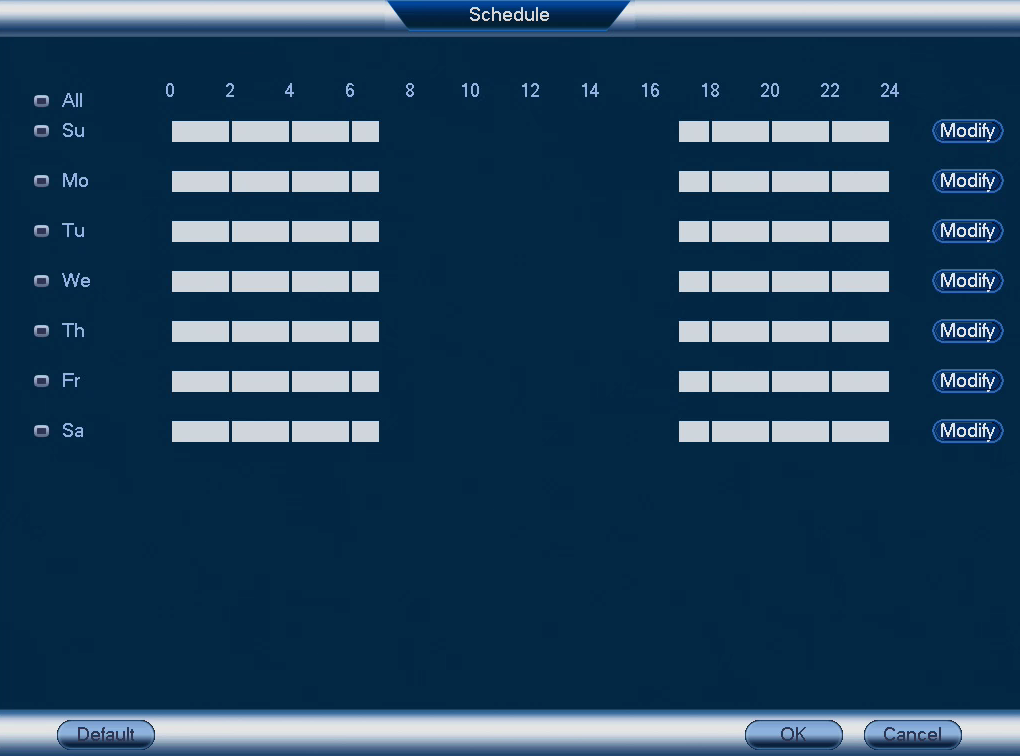
-
Click
 beside any days you want to link while adding/removing sections of the schedule, or beside All to link all days.
beside any days you want to link while adding/removing sections of the schedule, or beside All to link all days.
-
Click Modify to manually enter different time periods for the active hours on the selected day.
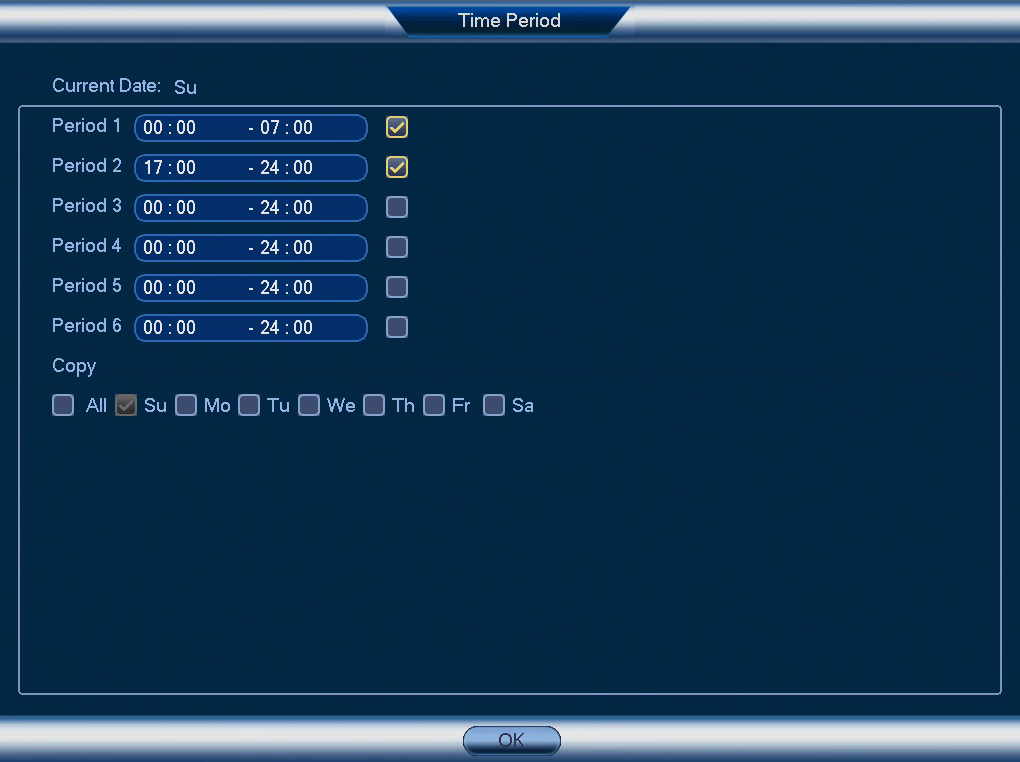
-
The default schedule is active during the night, between 5pm and 7am. Click or click-and-drag over portions of the schedule
you want to add/remove from the schedule.
- Enter a time in seconds next to Duration to determine how long the white light stays on per event.
- Select Warning Light for sustained light or Strobe for a flashing light.
- Click Apply to save changes.
- Click OK to exit.
14.3.11 Configuring Hard Drive Warnings
Hard drive warnings will notify you if an issue is detected with the hard drive.
-
From the Main Menu, click
and then click Event>Warning>HDD.
-
Under Event Type, select the hard drive event you would like to configure.
- No HDD: No hard drive detected.
- Disk Error: A hard drive error has been detected.
- Disk Full: The hard drive is full or almost full. You can enter the percentage of disk space remaining that will trigger a warning under Less Than (e.g. when less than 10% of the hard drive is empty, trigger a warning). Disk Full warnings will not occur if overwrite is enabled.
- All: Configure warnings for all hard drive events.
-
Configure the responses the system will take when the selected event occurs:
- Show Message: Show a popup message on the monitor.
- Send Email: Check to enable email alerts. You must configure email alerts before you will be able to receive them (see 14.3.4 Configuring Email Alerts ).
- Buzzer: Check to activate the system buzzer.
- Log Enable: Check to activate log.
- Click OK to save changes.
To configure hard drive warnings:
14.3.12 Configuring Network Warnings
Network warnings will notify you if there your system loses connection to the Internet or local network or if there is an
issue on your network.
-
From the Main Menu, click
and then click Event>Warning>Network.
-
Under Event Type, select the event type you would like to configure.
- Net Disconnection: The system has lost connection to the network.
- IP Conflict: More than one device on your network has the same IP address.
- MAC Conflict: More than one device on your network has the same MAC address.
- All: Configure responses for all network events.
-
Configure the following for the selected event type:
- Enable: Check to enable the selected event type.
- Show Message: Check to show a popup message when the selected event occurs.
- Send Email: Check to enable email alerts. You must configure email alerts before you will be able to receive them (see 14.3.4 Configuring Email Alerts ).
- Buzzer: Check to activate the system buzzer.
- Log Enable: Check to activate log.
- Click OK to save changes.
To configure network warnings:
14.3.13 Storage
The Storage menu allows you to configure the recording schedule and hard drives connected to the system.
14.3.14 Configuring the Video Recording Schedule
You can set a custom recording schedule according to your needs. For example, you can set the system to record continuously
during business hours and record on motion detection only outside of business hours.
A custom recording schedule helps reduce the amount of hard drive space required, increasing the time your system can retain
recordings.
To configure the video recording schedule:
-
From the Main Menu, click
and then click Storage>Schedule>Record.
- Under Channel, select the channel you would like to configure or select All.
-
Configure the schedule as needed:
- Check Continuous or Motion to select the recording type you would like to configure.
- Click and drag on each day to customize the recording schedule. The schedule is set up as a grid, with each block representing one hour.
-
Click
next to All to link the recording schedules for all days. The icon for a day changes to
when days are linked. You can also click the boxes next to individual days to link them to each other. If the recording schedule is linked, changes made to one of the days will apply to every day that is linked.
-
Click
to disable all recording of the selected type on the selected day.
-
Click
if you need to set a more precise schedule down to the minute.
- Click OK to save changes.
14.3.15 Configuring Pre-Recording
The system can pre-record video when motion detection events occur.
-
From the Main Menu, click
and then click Storage>Schedule>Record.
- Under Channel, select the camera you would like to configure or select All.
- Under PreRecord, select the duration for pre-recording.
- Click OK to save settings.
To configure pre-recording:
14.3.16 Configuring the Snapshot Schedule
You can set a schedule for recording snapshots from the cameras.
To set up the snapshot schedule:
-
From the Main Menu, click
and then click Storage>Schedule>Snapshot.
- Under Channel, select the channel you would like to configure or select All.
-
Configure the schedule as needed:
- Check Continuous or Motion to select the recording type you would like to configure.
- Click and drag on each day to customize the recording schedule. The schedule is set up as a grid, which each block representing one hour.
-
Click
next to All to link the recording schedules for all days. The icon for a day changes to
when it is linked. You can also click the boxes next to individual days to link them to each other. If the recording schedule is linked, changes made to one of the days will apply to every day that is linked.
-
Click
to disable all recording of the selected type on the selected day.
-
Click
if you need to set a more precise schedule down to the minute.
- Click OK to save changes.
14.3.17 Configuring Hard Drive Groups (Advanced)
Hard drive groups allow you to balance recordings across multiple hard drives. For example, you can record channels 1~4 to
one hard drive and 4~8 to a second hard drive. This can reduce the amount of wear on the hard drives and may extend the life
of the hard drives.
-
From the Main Menu, click
and then click Storage>HDD Advance>HDD Setting.
-
Under HDD Group, assign a group to each hard drive. To set up two hard drive groups, assign one hard drive to group 1 and the other to group
2.
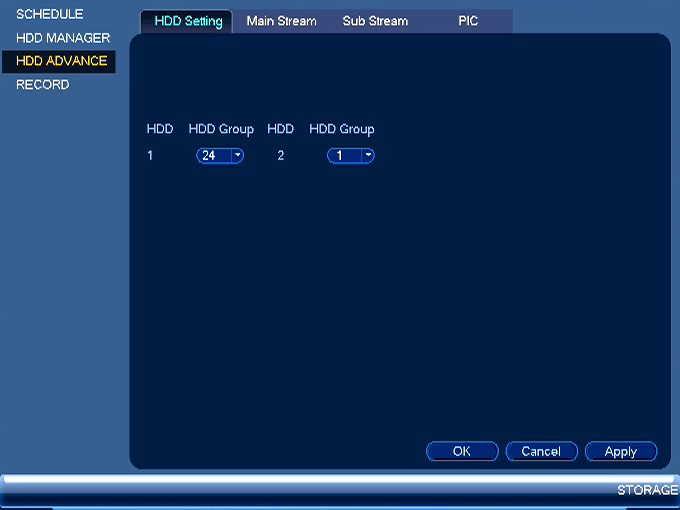
- Click OK. The system will restart to apply changes.
- When the system restarts, you must decide which channels will record to each hard drive group.
-
From the Main Menu, click
and then click Storage>HDD Advance>Main Stream. For each channel, select the hard drive group you would like to record the main stream (high quality) video and then click Apply.
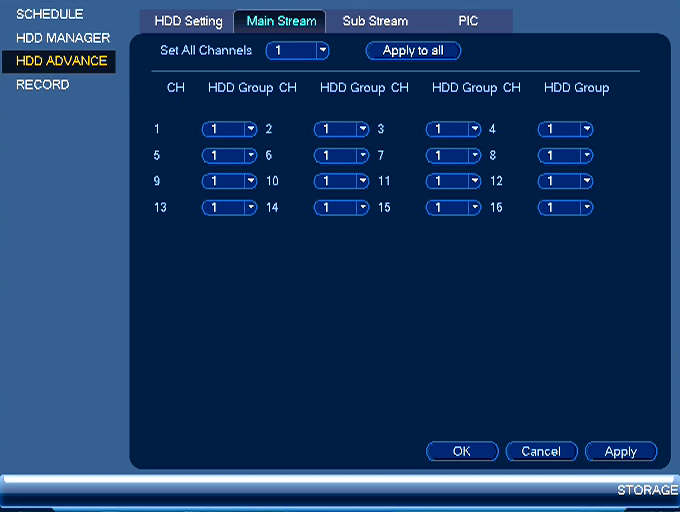
-
Click the Sub Stream tab. For each channel, select the hard drive group you would like to record the sub stream (reduced quality) video and then
click Apply.
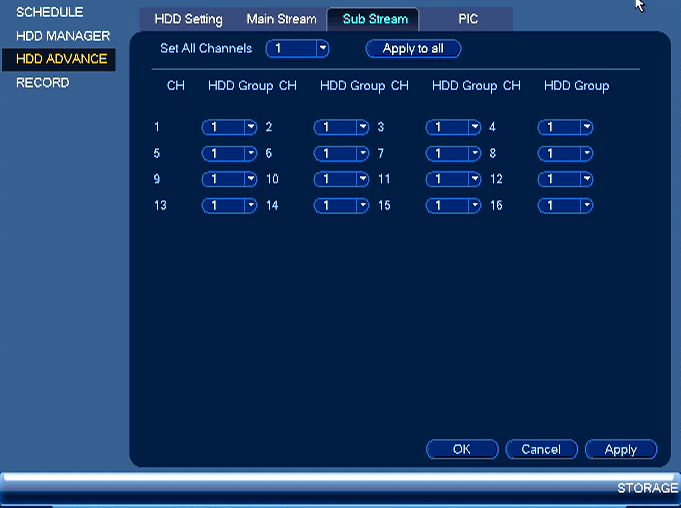
-
Click the Pic tab. For each channel, select the hard drive group you would like to record snap shots and then click Apply.
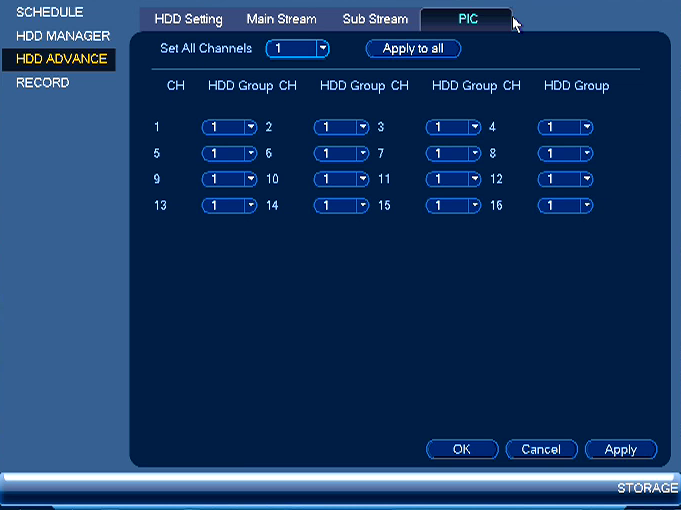
To configure hard drive groups:
14.3.18 Configuring Holidays
You can set certain days as holidays. Holidays have a special recording schedule.
-
From the Main Menu, click
and then click Setting>General>Holiday.
- Click Add New Holidays.
-
Configure the following:
- Holiday Name: Enter a name for this holiday.
- Repeat Mode: Select Once for the holiday to occur only this year or Always for the holiday to be repeated each year.
- Holiday Range: Select Date to select a specific date, or select Week to select holidays based on which week they fall on.
- Click Add. Now that you have added a holiday, an extra holiday setting is added to the recording schedule.
To configure holidays:
14.3.19 Formatting the Hard Drive
The HDD Manager menu allows you to format the hard drive. If you install a new hard drive, you must format the hard drive
using the system before you will be able to record.
-
From the Main Menu, click
and then click Storage>HDD Manager.
- Select the hard dive you would like to format and then click Format. Click OK to confirm.
- Click OK to save changes. The system will restart to complete the formatting process.
To format the hard drive:
14.3.20 Configuring Hard Drive Type
The system supports the following hard drive types:
- Read/Write: Normal recording hard drive.
- Read only: The system can playback data from this hard drive, but it will not record to it.
- Mirror: The hard drive will be used for mirror recording only. You must set up mirroring recording before this feature will work.
To set the hard drive type:
-
From the Main Menu, click
and then click Storage>HDD Manager.
- Click the hard drive you would like to configure.
- Choose the hard drive type under Type.
- Click OK to save changes. The system will restart to complete this operation.
14.3.21 Setting up Hard Drive Mirroring (Advanced)
A mirror hard drive can be used to automatically backup video footage recorded to the recording (read/write) hard drive. When
a mirroring hard drive is installed, the system can be set to record cameras in parallel to both the recording hard drive
and the mirror hard drive. This way, the footage is automatically backed up if the recording hard drive fails.
How hard drive mirroring works:
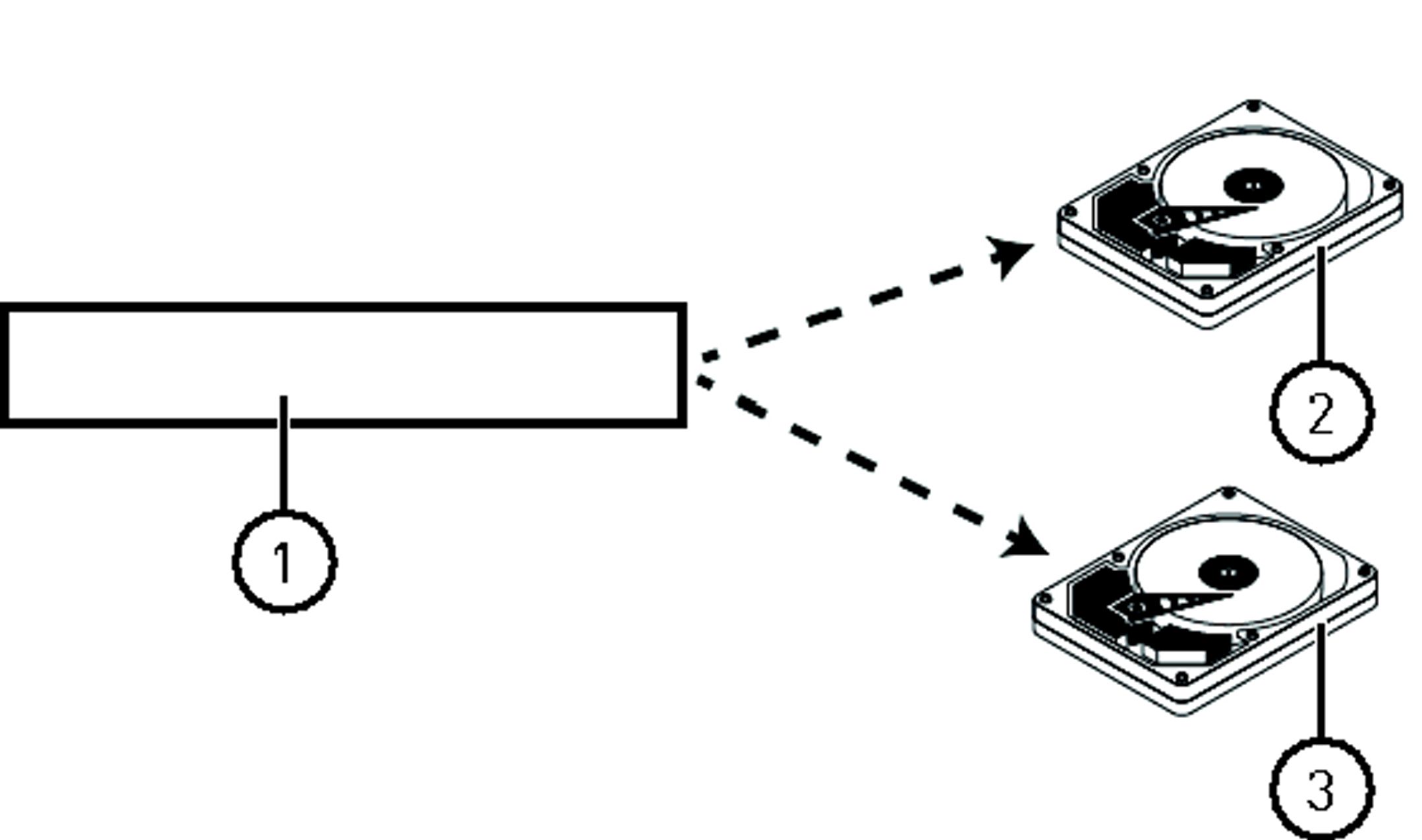
- Security system
- Primary hard drive
- Mirror hard drive
-
From the Main Menu, click
and then click Storage>HDD Manager.
-
Click the Type drop-down under the second hard drive and select Mirror.
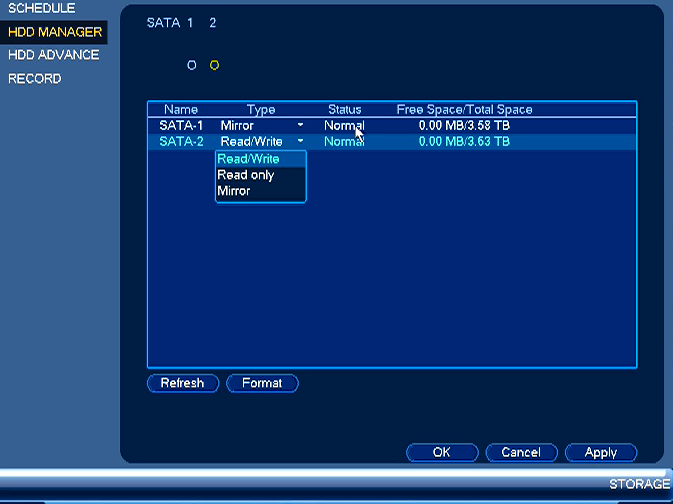
- Click OK to apply changes. Click Yes to confirm. The system will format the hard drive and restart.
-
When the system restarts, click
and then click Storage>Schedule>Record.
-
Under Channel, select the channel you would like to enable for mirror recording, then check Mirror. Repeat the process for any additional channels.
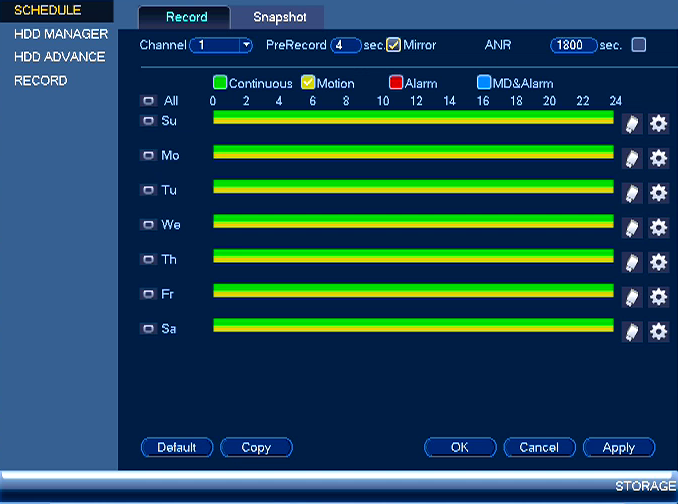
- Click OK to save changes.
To set up hard drive mirroring:
14.3.22 Configuring General System Settings
You can use the General menu to configure miscellaneous system settings.
-
From the Main Menu, click
and then click Setting>General>General.
-
Configure the following:
- Device No.: Select the remote control address of the system. See 7.1 Setting the Remote Control Address .
- Language: Set the system languages. Available options are English, French, and Spanish.
- Video Standard: Select NTSC (North America) or PAL (Europe).
- HDD Full: Select Overwrite for the system to overwrite the oldest recordings when the hard drive is full or select Stop Record for the system to stop recording when the hard drive is full.
- Pack Duration: Select how the duration (in minutes) the system will store video files. For example, if this is set to 30 minutes, the system will create a new video file for each 30 minutes of continuous recording.
- Instant Playback: Select the amount of time (in minutes) the system will go back when instant playback is activated in live view.
- Auto Logout: Select the idle time (in minutes) before the system will logout the current user.
- IPC Time Sync: Select how often (in hours) the NVR will update the time on the IP cameras.
- Navigation Bar: Check to enable the Navigation Bar that comes up when you left click in live view.
- Startup Wizard: Check to enable a setup wizard when you start up the system.
- Mouse Sensitivity: Use the slider to adjust the mouse speed.
- Click OK to save changes.
To configure general settings:
14.3.23 Setting the Monitor Resolution (Display)
The Display menu allows you to configure the systems monitor resolution and other display settings.
-
From the Main Menu, click
and then click Setting>Display>Display.
- Under Resolution, select the correct resolution for your monitor.
- Click OK to save changes. Click OK again to restart the system using the new resolution.
To set the monitor resolution:
-
From the Main Menu, click
and then click Setting>Display>Display.
-
Configure the following:
- Transparency: Select the menu transparency.
- Time Display: Check to show the time on the monitor.
- Channel Display: Check to show the channel names on the monitor.
- Image Enhance: Check for the system to digitally improve the video quality on the live display. This setting does not affect recordings.
- Original Scale: Set the system to show the true aspect ratio of the cameras on the live display. This may add black bars on the top and bottom of the image.
- Click OK to save changes.
To configure other display settings:
14.3.24 Saving Your System Configuration to a USB Thumb Drive
The system allows you to save your current system configuration to a USB thumb drive (not included). This is useful if you
want to backup your current settings.
- Insert a USB thumb drive (not included) into one of the USB ports.
-
From the Main Menu, click
and then click Setting>Config Backup.
- Under Device Model, select the USB device where you would like to save the configuration.
- Click EXPORT to save your current system configuration.
To save your system configuration to a USB thumb drive:
- Insert a USB thumb drive (not included) with a saved system configuration into one of the USB ports.
-
From the Main Menu, click
and then click Setting>Config Backup.
- Under Device Model, select the USB device.
- Click the folder with the configuration files you would like to restore. Configuration file folders are labeled “Config” and then the time and date the configuration was saved (e.g. Config_20140425103727).
- Click Import to restore the system configuration.
- Click OK to confirm. The system will restart to complete the operation.
To restore a saved system configuration:
14.3.25 Setting the System to Factory Defaults
The Default menu allows you to reset the system to factory default settings.
-
From the Main Menu, click
and then click Setting>Default.
- Check the menus you would like to reset to default settings.
- Click OK.
To reset the system to factory default settings:
14.3.26 Upgrading Firmware from USB
Firmware upgrades provide enhanced functionality. The system will automatically check for firmware upgrades if it is connected
to the Internet. The system also supports firmware upgrades from a USB thumb drive (not included).
- Download the firmware upgrade from www.lorex.com/support .
- Extract the firmware file and copy the firmware to a blank USB thumb drive.
- Insert the USB thumb drive to a USB port on the system.
-
Right-click and then click Main Menu. Click
>Setting>Upgrade.
- Click Upgrade.
- Select the firmware file on the USB drive and click Start.
To upgrade firmware from a USB drive:
14.4 Shutdown
Use the Shutdown menu to shutdown, restart, or log out of the system.
- From live view, right-click and select Main Menu.
- Enter the system user name and password and click OK.
-
Click
>Shutdown.
-
Select one of the following:
- Logout: Log out the account that is currently active.
- Shutdown
- Restart
To access the Shutdown menu:


























